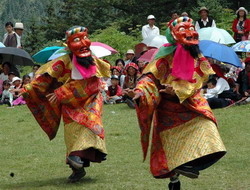|

The Gyantse Damma Festival has a history of more than 500 years.
It is said that Gyantse King, Pabasangbu had a lot of prestige in the Geshar Dynasty. After his death, his disciples held the worship to memorize him. But it was interrupted because of the war. In 1408, the Gongsang Raopa King, the son of Paba Sangbu, resumed the worship.
From April 10 to 27 of Tibetan calendar, Gongsang Raopa held the worship and recreational activities to memorize his father. Activities include the display of Buddha Portrait, sorcerer's dance in a trance, wrestling and bearing contest. When the Zhaxi Raodan enthroned the Gyantse-King in 1447, the horsemanship, archery, Tibetan opera, dancing and singing were supplemented, forming the Gyantse Dama Festival still being observed today.
Another story says that the festival originated in the celebration of the completion of the Palkor Monastery.
Today, the Dharma Festival starts with Buddha painting unfolding festival on April 15 on the Tibetan calendar as a prelude every year, and officially opens on April 18. The 19 townships in the Gyangze County gather to celebrate the festival, which also attracts people from everywhere.
Today, the Dharma Festival is not only a folk festival but an exchange with a theme of promoting economy through cultural activities. During the festival, besides traditional sport items such as shooting on horseback, there are other contemporary pastimes such as ball games and track events. Around the sports ground are tent shops where trade takes place, and tents of farmers and herdsmen who come from afar.
During the festival, farmers will drive their horse carts to bring their families to the annual festival. Some are fond of races, some like to watch performances, while still others will set up stands to sell home-made sweet milk dregs and other products. But most people will stay in their own tents and enjoy themselves until nightfall. The Dharma Festival usually lasts seven to 10 days.
 China tours inclusive of visiting Gyantse China tours inclusive of visiting Gyantse
|
|